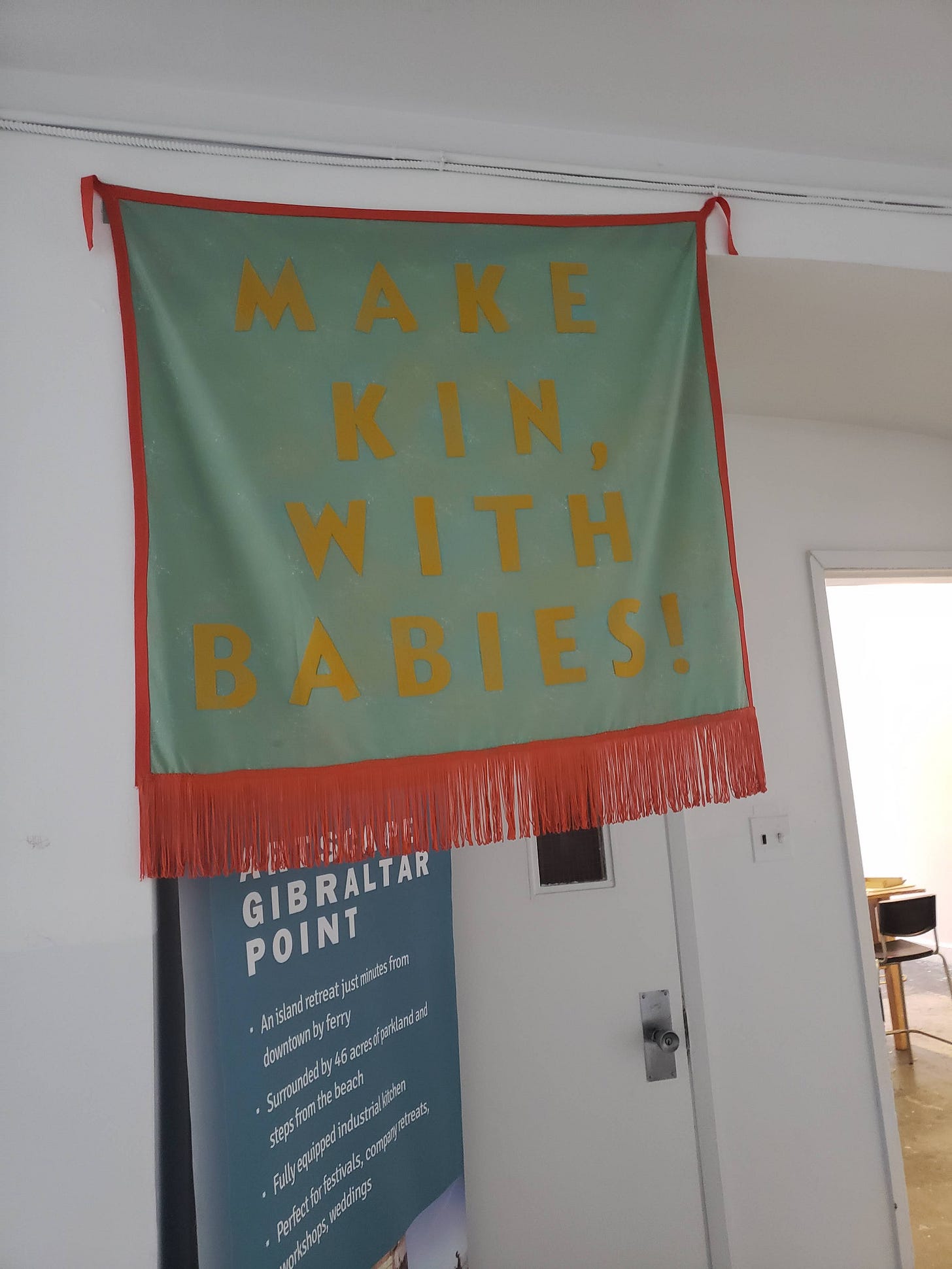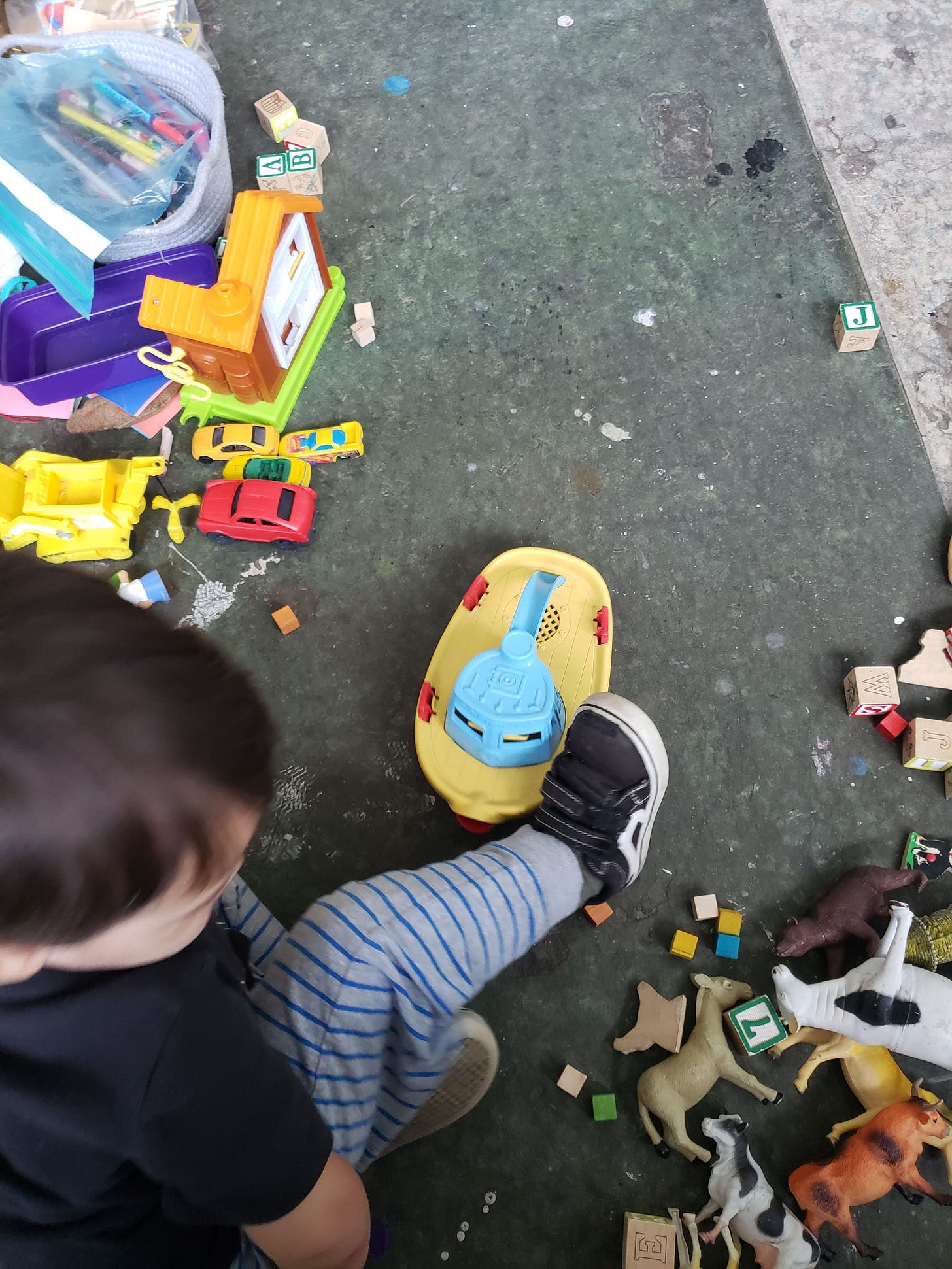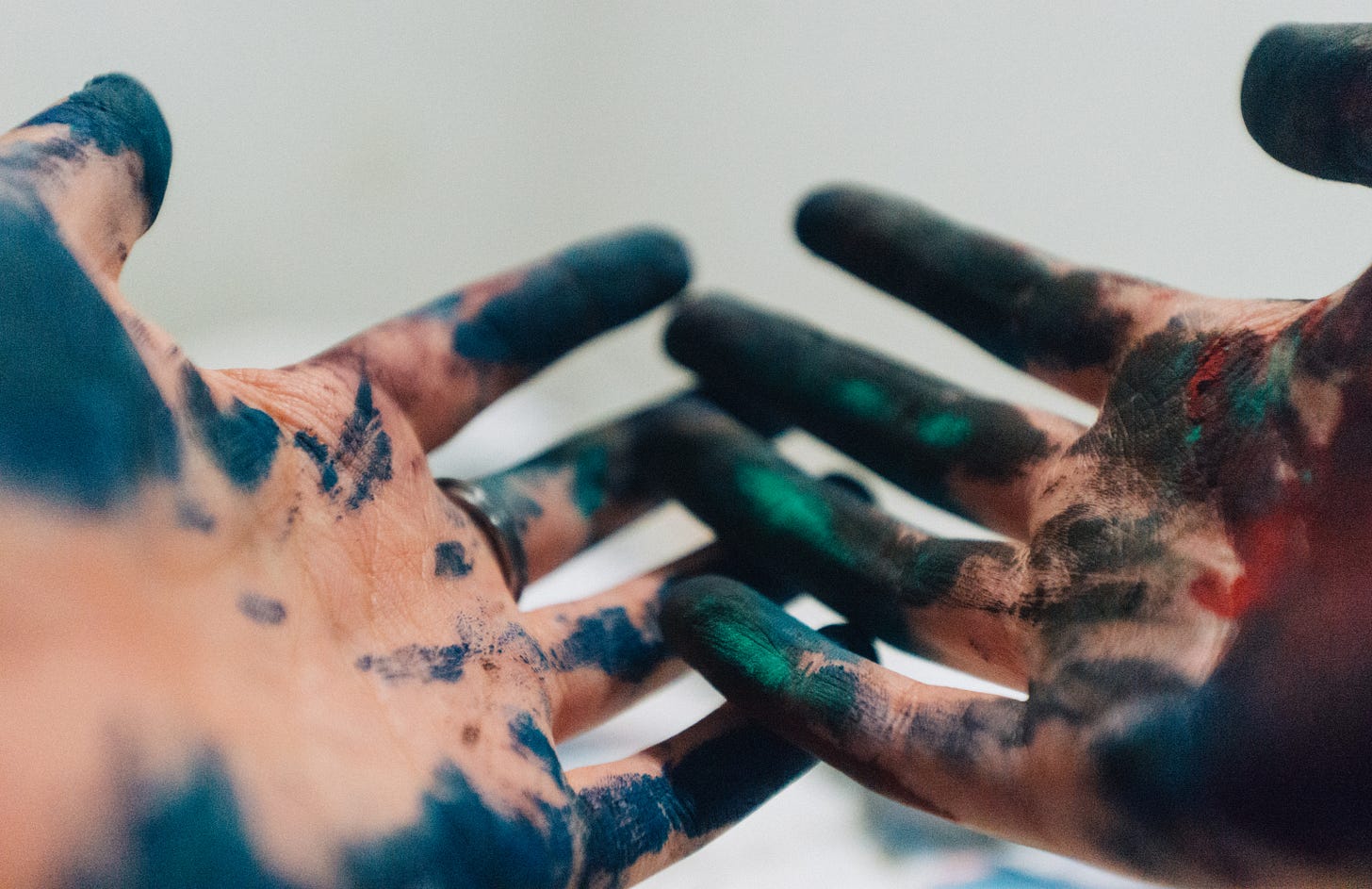Experimenting with models of creative process and productivity while parenting
Or how MOTHRA, an artist-parent residency, inspired me with models of creative parenting and family life that I needed
On the Toronto Islands, a short ferry ride away from Toronto’s financial district, Artsape Gibraltar Point (once known as the Gibraltar Point Centre for the Arts), hosts a child-inclusive artist-parent residency named MOTHRA, once every quarter.
MOTHRA is one of Canada’s first child-inclusive artist residencies, founded in 2018 by Sarah Cullen with help from Alison Thompson, Simon Pope, Mary Dyja, and others. Sarah, an artist herself, has two children of her own and a year-round studio space on site where she creates solo and with her family.
I attended MOTHRA September 2022 with my son — then one year and nine months old — for an eight-day experiment in creative production. I say experiment, because like I described in my first post, How creative ideas fuel the work, even before there is anything called work, I had been working out a lot of creative problems in my mind, without much time to work them out with physical materials, and I didn’t know if it would be successful at all. If I could actually do both: parent and produce.
Partners are allowed to attend as well, and my partner came a few nights for relief, but it was largely going to just be me and my son for the entire week, trying to balance my goals for writing and my necessity of keeping my toddler busy enough to allow me to set pen to page.
I packed our bags in anticipation with all our necessities for an eight-day adventure on an island with no grocery stores or pharmacies — or even cars. I ordered my son his own large format sketchbook and some paints from Collage Collage, one of my favourite shops in Vancouver, packed a few books and toys, and plenty of clothes and hoped for the best. We bought a used bike trailer so I could get around on my bike and be able to pack over my luggage. And I took the streetcar to the Jack Layton ferry terminal, where I first met some of the artists: printmakers and illustrators, textile artists, dancers and multidisciplinary artists. I was the only writer.
Formerly an old school house off the sandy shores of Lake Ontario, Artscape Gibraltar Point is surrounded by wild organic gardens and sandy beaches. On site, numerous artists have year-round studios, and many more travel from across Canada and the U.S.A. to participate in both themed and unthemed artist residencies, not far from the vibrant bustle of Toronto’s downtown. Outside the artist space parks an old 1960s Blue Bus used to transport travellers to and from the ferry docks, but it was broken down so we had a mini-van that took turns loading up and taking us to the site.
Accommodations are modest-at-best, especially compared to the design-forward Banff Centre for Arts and Creativity where I attended in 2017, so you won’t find it on a tourism brochure for Toronto. But even with its thrift-store kitchen and its stooped IKEA furniture, it has been transformed through the imaginations of 100s of artists who have passed through this place in the decades since it was claimed. Paintings and sculptures, and even found objects enliven this old school.
Sarah personally collected all the childcare resources that were on offer at the child-inclusive residency: a high chair, a baby bath, containers to hold bags of Ontario milk, a play kitchen for while you were making meals, and old toys and art supplies for the children’s studio.
I had a small room, perfect for writing at night while my son slept in the bed. It had a double bed with a small desk, just across from a shared washroom with stand-up shower. Originally it must have been a teacher’s office or maybe a classroom, and it still had its linoleum floor, but now it felt like a hostel. The only beautiful finding was the curtains, handsewn sheer panels and embroidered words; they fluttered in the wind when the window was open. I had the sense that the whole space was all cobbled together out of people gifts and hand-me-downs.
But I also had a access to a shared studio (and you can even get your own if you pay a little more). I shared a big bright studio with a printmaker, Marlene Yuen. She spread out on the large table and I set up to write at the desk by the window. There was a large door which opened up to a ramp and a small greenhouse. I liked to see visual artists as work, as someone who studied art history and has dabbled in visual arts and who has worked in arts and culture, I loved the opportunity to watch an artist at work. Her small family was staying on site and they were making art too, which was even more inspiring to see, because then I had a model for what my young family could be too: creating and making creativity a centerpiece for our family life. I wanted that and I still do.
Once I found a rhythm, I spent most time on site in the children’s studio where I could sit on the sofa and write longform in a notebook, with sources to consult and ideas to perculate on the page. I wrote consistently while son crawled around on the studio mats, playing cars.
The kitchen became a centerpiece for conversation during the residency, with parents coming in and out with their kids to prepare meals and to make coffee. It’s where I met other parents and discussed their practice with them. I talked breastfeeding with one mom. I talked solo parenting with another. I gathered ideas and methods for creative parenting. I saw examples of what I could do. I learned from other creative parents how to persist despite the interruptions, but I also learned how to embrace the interruptions, how to include children in art practice.
I wrote in my book on the first day of the residency:
“I feel challenged by the idea of being an artist-parent, because being a parent is a whole, consuming identity. But I am also a writer, and I can also explore other roles and forms.”
It seemed to be a rallying call to overcome my own self-doubt.
I still have that self-doubt, that it can be done at all.
As I think of this now, as I try to write this and have been interrupted numerous times by family members who want something to eat or who want to know what I am doing, how hard it is to limit ourselves, or even to even drop that part of ourselves that IS us, who we are and how we find meaning in the world — our creative identity.
But even with this, and what I want most to explore now, is how to persist, imperfectly. Creating in the “shallow” places, as Sarah Cullen described to me at the residency, even if an eight-day residency seems to offer space for the deep work, it’s best to let go of expectations and maybe letting go of expectations allows for more creativity, because we are free to experiment, we are free to make tiny experiments throughout the day. And that’s really what this residency was: it was an experiment in process, in practice. It was about experimenting with how and why I do my practice through parenting; how I can continue with writing despite this conflict between the solo practice touted by the childless literary giants like Virginia Woolf in “A Room of One’s Own” and the need to share space, constantly, both physically with our bodies and in physical space like the rooms we occupy, as a parent.
And while I have so much more to say about MOTHRA, what was most evident from this residency, is the need to have models for creative parenting. The need to see and surround yourself with examples and inspirations and even just interviews with other creative parents. Because we need to see how it is done and we need to experiment with our process to make creating work with parenting.
I am experimenting with process right now, as I write this passage and as I am asked how much longer I will be this Sunday morning to make my own self-imposed deadline; how much longer must I be here occupied with something other than family life this Sunday.
As I look down a long week of my 9-to-5, and a week of parenting in evenings, I say: just a while longer. I am almost done.
And that in itself is an experiment in process, productivity.
Exercise
Writing Prompt: Plan out an experiment in process or productivity while parenting. What could this look like for your medium? What goal or intention for your creative work will you have? How will your children be involved or even just present?
Exercise: Now try it out. Note when you let go of your own expectations or perfectionism in the final product.
Dog Ears
Virginia Woolf’s “A Room of One’s Own” (1929)
Collage Collage: “Collage Collage is a place that strives to uphold the tremendous creative abilities that children have, in surroundings that adults find equally stimulating, provoking and above all, inspiring.”



